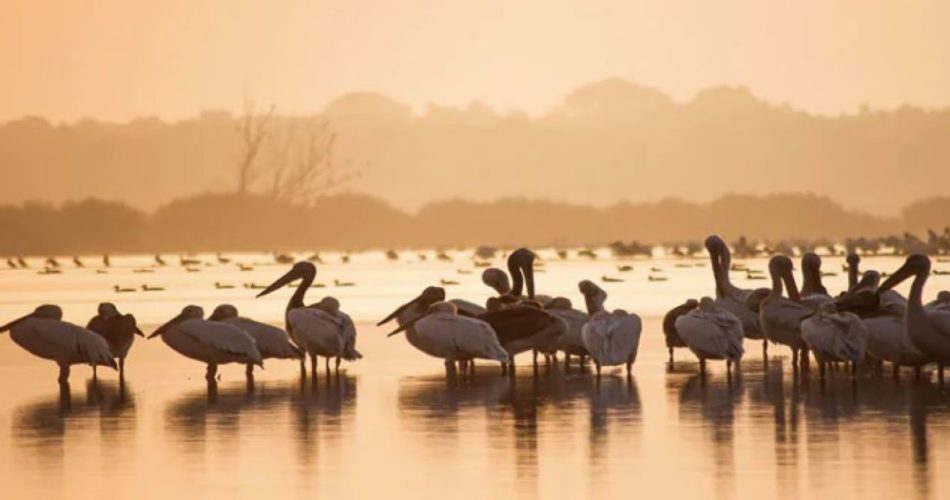Why in news?
India has added 10 more Ramsar sites, or wetlands that are of international importance, taking the number of such sites to 64. India is aiming at getting a Ramsar tag for 75 of its wetlands on the 75th year of Independence.
Wetlands in India:
- Wetlands cover 6.4 per cent of the geographical area of the world.
- The National Wetland Inventory and Assessment compiled by the ISRO estimates India’s wetlands to span around 1,52,600 square kilometres which is 4.63 per cent of the total geographical area of the country.
- So far, 64 wetlands covering an area of 12,50,361 ha have been designated as Ramsar Sites of International Importance from India.
- The U.K. (175) and Mexico (142) — smaller countries than India — have the most Ramsar sites, whereas Bolivia spans the largest area with 1,48,000 sq.km under the Convention protection.
How can a site qualify to be a RAMSAR site?
- If supporting vulnerable, endangered, or critically endangered species or threatened ecological communities
- If it regularly supports 20,000 or more waterbirds
- If it is an important source of food for fishes, spawning ground, nursery and/or migration path on which fish stocks are dependent upon.
Also Read : Gati Shakti University: Things to Know about Gati Shakti Vishwavidyalaya for UPSC Current Affairs!

RAMSAR Sites in India:
| State/UT | Names of Sites |
| Andhra Pradesh | Kolleru Lake |
| Assam | Deepor Beel |
| Bihar | Kanwar Lake |
| Goa | Nanda Lake |
| Gujarat | Khijadiya, Nalsarovar, Thol Lake, Wadhvana Wetland |
| Haryana | Sultanpur National Park, Bhindawas Wildlife Sanctuary |
| Himachal Pradesh | Chandra Taal, Pong Dam Lake, Renuka Lake |
| Jammu and Kashmir | Hokersar Wetland, Surinsar-Mansar Lakes, Wular Lake |
| Karnataka | Ranganathittu Bird Sanctuary |
| kerala | Ashtamudi Wetland, Sasthamkotta Lake, Vembanad-Kol Wetland |
| Ladakh | Tsomoriri, Tso Kar |
| Madhya Pradesh | Bhoj Wetland, Sakhya Sagar, Sirpur Wetland |
| Maharashtra | Nandur Madhameshwar, Lonar Lake |
| Manipur | Loktak Lake |
| Mizoram | Pala Wetland |
| Odisha | Bhitarkanika Mangroves, Chilika Lake, Satkosia Gorge |
| Punjab | Beas Conservation Reserve, Harike Wetland, Kanjli Wetland, Keshopur-Miani Community Reserve, Nangal Wildlife Sanctuary, Ropar Wetland |
| Rajasthan | Keoladeo National Park, Sambhar Lake, |
| Tamil Nadu | Point Calimere Wildlife and Bird Sanctuary, Karikili Bird Sanctuary, Pallikaranai Marsh Reserve Forest, Pichavaram Mangrove, Koonthankulam Bird Sanctuary, Gulf of Mannar Marine Biosphere Reserve, Vembanur Wetland Complex, Vellode Bird Sanctuary, Vedanthangal Bird Sanctuary and Udayamarthandapuram Bird Sanctuary. |
| Tripura | Rudrasagar Lake |
| Uttar Pradesh | Bakhira Sanctuary, Nawabganj Bird Sanctuary, Parvati Arga Bird Sanctuary, Saman Bird Sanctuary, Samaspur Bird Sanctuary, Sandi Bird Sanctuary, Sarsai Nawar Jheel, Sur Sarovar, Upper Ganga River |
| Uttarakhand | Asan Barrage |
| West Bengal | East Kolkata Wetlands, Sundarban Wetland |
Practice Mains Question:
Wetlands are critical to human and planet life. In light of this, discuss the significance and threat to wetlands and efforts for wetland conservation. (15 marks)
Also Read : Updated Nationally Determined Contribution : Current Affairs for UPSC !
Summary

Article Name
RAMSAR Sites in India : UPSC Current Affairs Booster
Description
India has added 10 more Ramsar sites, or wetlands that are of international importance, taking the number of such sites to 64. Let's dig in to know more.
Author
ufaber
Publisher Name
UPSC Pathshala
Publisher Logo

Show Comments





